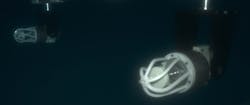ROG.e 2024: New cathodic protection monitoring workflows
By Svenn Magne Wigen, FORCE Technology AS
With Petrobras taking a leading role in developing the technologies and capabilities needed for deepwater drilling, Brazil is today recognized as an important region for the application of cutting-edge new solutions aimed at optimizing and reducing the cost of installing and maintaining complex subsea infrastructure.
Brazilian deepwater still presents challenges, however, including the ongoing need to reduce the cost of maintenance, and a significant aspect of this is looking after the cathodic protection (CP) used to protect underwater structures from corrosion.
Developed by FORCE Technology, the FiGS (field gradient sensor) technology is a significant upgrade over the traditional methods used to measure the health of CP systems. Conventional monitoring and inspection techniques typically involve the use of divers and ROVs fitted with CP probes, which must touch the pipeline or structure to obtain readings. While divers conduct manual inspections, these methods are often slow, costly and present notable safety risks, especially at deepwater installations.
The challenges in monitoring CP systems emphasize the need for technologies that can deliver more precise, efficient and cost-effective solutions. The FiGS tool is designed to offer enhanced data accuracy and improved operational efficiency, without the need to come into contact with the structures it measures. Unlike traditional CP probe methods, the highly sensitive FiGS measures electric field gradients in the seawater surrounding the structure. This approach allows for a more precise and comprehensive assessment of the structure's CP system without the need for divers or ROVs to ensure physical contact.
The advantage lies in the sensitivity of the sensors, which can detect even the smallest variations in electric fields caused by current flow from the anodes to the metal surface. This precision enables the system to identify early signs of issues such as coating damage or unexpected anode depletion rates—problems that might go unnoticed with conventional methods. By providing a detailed map of the CP system’s performance, FiGS allows operators to proactively address potential failures before they escalate, thus enhancing the safety and longevity of subsea infrastructure.
Offshore surveying
Another major draw is operational efficiency. Traditional inspections can be slow, costly and require extensive manual labor. In contrast, FiGS surveys are faster, covering large areas efficiently with ROVs or AUVs traveling at speeds of up to 6 to 8 km/h on pipelines. This not only reduces downtime but also minimizes operational risks by allowing data collection from greater distances, even in difficult deepwater conditions.
Moreover, the technology is versatile, functioning effectively on various pipeline types, including buried, trenched or rock-dumped pipelines, and it integrates seamlessly with pipe tracking systems. This, combined with the ability to provide accurate reports on anode current output, steel current density and CP system life expectancy, ensures that FiGS surveys can deliver additional data and insight.
Offshore Brazil applications and case study
Considering the operating conditions in key Brazilian areas known for deepwater and ultradeepwater oil production, such as the Campos Basin, Santos Basin and Espírito Santo Basin, the FiGS technology is a new technology for this offshore area. While still relatively early in its introduction to the region, several projects have already been completed offshore Brazil.
One project entailed the survey of the CP health of a platform that was to undergo life extension and retrofit, as the original design life had expired. FiGS was used to determine the remaining life of the originally installed CP anodes. With the high-sensitivity field gradient sensor technology, accurate calculations of anode current output and structure current density were possible, which enabled the creation of the effective design basis for an optimized CP retrofit.
FiGS is outlined in the ROG.e conference paper Utilisation of Highly Sensitive Field Gradient Sensor for Optimisation of Cathodic Protection Life Extension. FORCE Technology is exhibiting with its partner IEC Engenharia at booth L05 at ROG.e 2024 this week in Rio de Janeiro, Brazil.
About the Author

Svenn Magne Wigen
Svenn Magne Wigen has a bachelor's degree in material technology and corrosion as well as a bachelor's degree in construction engineering. He has worked with cathodic protection (CP) and corrosion control design and modeling since 2001. Working on worldwide projects, his experience covers CP design and engineering, fabrication drawings, project management, offshore/onshore inspections and supervision, company management, sales and marketing. He specializes in stainless steels and BEM/FDM computer modeling and is also an EN 15257 CP specialist.
